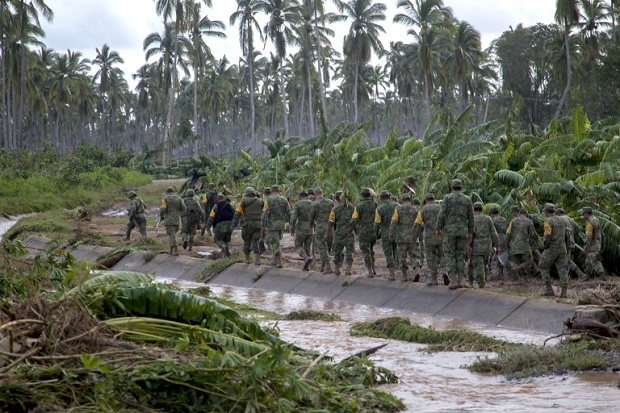How did Mexico dodge the Hurricane Patricia bullet?

Mexican soldiers patrol looking for people who ask for help after the passage of hurricane Patricia in El Rebalse community, Mexico on October 24, 2015. Patricia flattened dozens of homes on Mexico’s Pacific coast, but authorities said Saturday the record-breaking hurricane largely spared the country as it weakened to a tropical depression. AFP
MEXICO CITY, Mexico –Mexico dodged a bullet when monster Hurricane Patricia failed to live up to its threat of devastating huge swaths of the country. What saved Mexicans?
Experts say Mexico was saved from widespread destruction in big part thanks to the Sierra Madre Occidental mountains, which slowed Patricia’s wrath.
The coastal region where it made landfall in western Jalisco state is also sparsely populated by fishing village, whose residents had evacuated to shelters.
The preventive evacuations by the authorities played an important role, along with a lower pressure in the north that affected Patricia’s trajectory.
Patricia struck the Pacific coast as a massive Category Five hurricane late Friday, but almost 24 hours later President Enrique Pena Nieto declared that no major damage was detected.
Article continues after this advertisementDozens of small homes were flattened in Chamela, a fishing village in Jalisco state, and 250 more were hit by floods elsewhere.
Article continues after this advertisementBut it was not the widespread devastation expected for a hurricane that packed a record 325 kilometers (200 miles) per hour winds before it made landfall.
When Patricia struck the coast, its winds slowed to 270 kilometers per hour, and gradually lost steam as it moved inland.
Transport Minister Gerardo Ruiz Esparza said Mexico was “lucky” that Patricia took a last minute turn and struck the Sierra Madre.
“Nature was kind-hearted,” he said.
READ: Megastorm Patricia fades into low pressure area | Mexico’s most devastating storms
Uninhabited region
Pier Luigi Vidale, professor of climate system science at Britain’s University of Reading, said the radius of Patricia’s maximum winds was extremely small at 12 kilometers, “so it fit very well in the space” between the towns of Campo Acosta and La Barra de Navidad.
“The issue is exposure: luckily, it made landfall in a rather uninhabited region,” he said.
While a second eyewall had a maximum winds radius of 100 kilometers, the distance between two inhabited locations was about the same.
“The storm continued straight to Sierra del Cuale, passing only through uninhabited zones, and rapidly lost intensity. We could hardly have been luckier,” Vidale said.
Patricia was also influenced by its interaction with a low pressure extending from the north to the west of the country, said Leodegario Sanson, president of the Mexican Meteorologist Organization.
The low pressure stole some of the hurricane’s clouds and “accelerating the cyclone’s movement toward the northeast” and the mountains, Sanson told AFP.
In the past 24 hours, Patricia gradually weakened to a tropical storm, a depression and a “low remnant” as it moved northeast, according to the US National Hurricane Center.
The Philippines were not as fortunate when Super Typhoon Haiyan, with its 315 kilometers per hour winds, left more than 7,350 dead or missing when it struck in November 2013.
“The conditions between countries like the Philippines and Mexico are very different,” said Jaime Albarran Ascencio, meteorologist at Mexico’s governmental National Meteorological Service.
“Over there (in the Philippines) there were many people were crowded together close to the coast and the hurricane got them,” he said.
But in the path of Patricia, he said, the homes were built better and there was “very good information” given to residents.